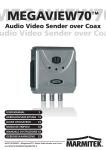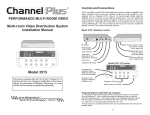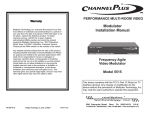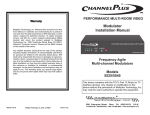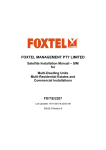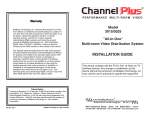Download Channel Plus SVM-24 Installation manual
Transcript
PERFORMANCE MULTI-ROOM VIDEO Warranty Multiplex Technology, Inc. warrants this product to be free from defects in materials and workmanship for a period of one year from the date of purchase or MTI will repair, or at its option, replace the defective product. To obtain warranty service, call MTI for a return material authorization (RMA) number and return the product prepaid to Multiplex Technology, Inc., 3001 Enterprise Street, Brea, CA 92821, Attention: Customer Service. Please put the RMA number on the outside of the carton. Any implied warranty arising from the sale of the product including implied warranties of merchantability and fitness for purpose are limited to the warranty stated above. MTI shall not be responsible for losses or damages or expenses, whether direct, consequential or incidental arising from the use of or the inability to use this product. Some states do not allow limitations on how long the implied warranty lasts or the exclusion or limitation or incidental or consequential damages, so the above limitations and exclusions may not apply to you. This warranty gives you specific legal rights, and you may have other rights which may vary from state to state. Modulator Installation Manual SVM-24 A B C D select program IR Frequency-Agile MTS Stereo Multi-channel Modulators with S-Video Inputs Models SVM-24 / SVM-22 This device complies with the FCC's Part 15 Rules for TV interface devices. Any change or modification to this device without the permission of Multiplex Technology, Inc. may void the user's authority to operate this equipment. 3001 Enterprise Street, 600-224 Rev. B Multiplex Technology, Inc., Brea, CA 92821 Brea, CA 92821-6213, U.S.A. 714-996-4100 * 800-999-5225 * FAX 714-996-4900 * www.channelplus.com The ChannelPlus SVM Series are digitally-tuned video modulators that convert any baseband video and audio signal to a user-selected UHF, or Ultraband CATV. An internal quartz crystal reference oscillator and PLL circuitry ensure drift-free performance. The user selects the output frequency (channel) using the "select" button to choose which modulator and the "program" button to enter the number of the desired channel. Any TV connected to the output via coax can receive the signals, when the TV is tuned to the proper channel. In addition, the SVM series encodes each channel using the MTS stereo standard. Stereo sound and surround sound information will be received by any MTS compatible television receiver. Models available: SVM-24 4 channel modulator SVM-22 2 channel modulator Changing modulation standards Cable HRC and IRC considerations Most cable services use IRC frequency assignments. This is the default for the ChannelPlus SVM series modulators. However, if the cable service uses HRC or the TV appears to search for the "house channels," the modulator can be reprogrammed to use HRC assignments by entering the number “ 98”. Set to IRC by entering a “99”. Both of these settings are only used for setting HRC/IRC. Note: This setting can be entered on any modulator channel, A, B, C, or D, and affects all channel assignments for that unit. Cable channels must either be all IRC or all HRC. Controls and Connections - Model SVM-24 shown SVM-24 Front A B C D select program Specifications: typical @ 25OC ± 5OC IR SVM Series modulators LEDs show which modulator is selected Select button chooses the modulator (A/B/C/D) Program button enters the channel number LED shows IR data transmission Inputs Video performance Right audio output Left audio output S-video output VIDEO RF Output Power input AUDIO L AUDIO R CH A CH A CH B CH B POWER 15VDC 900mA CH C CH D OUTPUT CH D Back CH C RF output VIDEO AUDIO L AUDIO R VIDEO AUDIO L AUDIO R VIDEO AUDIO L AUDIO R S-video input Left audio input Right audio input IR emitter outputs AUTO TERMINATE FEATURE All SVM modulators have built in loop through connectors so the user can connect video to a second device. SVM modulators terminate the inputs into a 75 ohm load. When a second cable is connected to the output, the SVM automatically disconnects this termination to allow the second device to terminate. BASEBAND VIDEO The SVM modulators come with converter plugs for regular baseband video sources. These can be used on inputs or outputs. MOUNTING The SVM modulators can be mounted in standard 19” racks by attaching the included mounting ears. Remove the rubber feet on the bottom of the unit to ensure clearance when inserted into a rack. 2 Power supply Physical MTS audio performance s-video audio differential gain differential phase signal/noise standard channel ranges output level IM distortion alternate channel model number output current output voltage input power power consumption height width depth weight frequency range signal/noise separation surround sound noise reduction 7 1 Vp-p @ 75 1 V rms @ 47k 4% <4º 55 dB UHF 14-64 CATV 65-125 (excluding 95-99) +25 dBmV (85dBuV) -60 dBC -45dBC @ 12MHz SVM-22 900mA SVM-24 900mA 15 VDC 105-125 VAC 9 watts 11 watts 4.4 cm (1.75 in) 43.2 cm (17 in) 16.5 cm (6.5 in) 1.19 kg (2 lbs 10 oz) 20Hz - 12kHz 65 dB 25 dB @ 1000Hz Compatible with Dolby full logic surround sound Certified dbx Sample System Diagram No picture … Verify that the video source is on and is producing a video signal. Check that the TV and the modulator are tuned to the same channel. For example, if the modulator is broadcasting on UHF channel 16, make sure the TV is on UHF 16 rather than CATV 16. UHF 16 and CATV 16 are at different frequencies. Local monitor CCTV Camera at front door LEDs blink ... You need to have one unused channel space between channels. The display will blink if you have made an ‘illegal’ choice. See the section on programming. Use converter plug for baseband sources without s-video outputs like cameras. For applications using the converter on the input, use another on the output to loop to a baseband monitor. Herringbone interference on ChannelPlus channel (diagonal lines) ... You may have chosen a channel number that is not completely vacant. Distant UHF stations may be un-watchable, but will cause interference if you try to create a new channel at the same frequency. Also, cable companies often have extra signals where there should be none. Try moving the ChannelPlus channel to another number. You may have to add a low pass filter to remove cable company noise. VIDEO Audio volume seems low compared to broadcast … There may be little you can do here, other than turn up the volume. Here is what is happening: ! ! In broadcast television, the audio is compressed: The soft sounds are amplified to be almost as loud as the loud sounds. The technical measure of this is dynamic range, the ratio of loudest to softest sounds. The dynamic range of video devices such as DVD and LV players is very great. Since most of a typical movie consists of ‘soft’ sounds, the audio will seem quieter than normal television channels. (This is also why commercials, which are the most compressed, seem louder than the program they accompany.) To appear to be at the same volume as broadcast channels, the audio level in a modulator is carefully increased. In the modulator, too high of signal level can overdrive the MTS circuits and audio performance will suffer. No Stereo … When using the TV outputs to send audio to a home theater system, be sure the TV is in the stereo mode for external speakers. Consult the TV manual, this is often confusing and is different for different TV brands. No color on ChannelPlus channels … You may have chosen the incorrect cable standard. Not all televisions can accommodate the 1.25MHz frequency difference between the H and I cable standards. See the section on programming. 6 AUDIO L AUDIO R CH A CH B CH C CH D POWER 15VDC 900mA CH D OUTPUT Herringbone interference on many channels (disappears when you remove the modulator) … The high output of the ChannelPlus modulator can overdrive many RF amplifiers. Reduce the RF output using an attenuator. (ChannelPlus coax panels are designed to take the full output of these modulators.) CH C SVM-24 CH B Weak ChannelPlus UHF channel … If the TV has a separate UHF input, be sure that it is connected. In this system, CATV or antenna channels are available on all TVs. In addition the following channels have been added: Channel 66 - DVD player Channel 68 - Front door channel Channel 70 - WebTV Channel 72 - Satellite receiver CH A Things to watch for: VIDEO AUDIO L AUDIO R DVD VIDEO AUDIO L AUDIO R VIDEO AUDIO L AUDIO R SAT WebTV Attach the IR emitter directly over the IR sensor. RG6 coax preferred DA-550 (Distributes to as many as 8 TVs) To more TVs 2100A Any or all TVs may have a model 2132 IR Target TARGET LED EMITTER CATV/Antenna POWER TO TV Control the DVD, DSS or VCR from any room. 3 Programming Examples: Valid Channels: 14-64: UHF channels 65-125: CATV channels 95-99: not valid Channel Spacing: Skip at least one number between channels. Channels 14 and 16: OK. Channels 14 and 15: Illegal. Error indication: If an error has occurred or an incorrect channel is entered, the LED will flash quickly for a second and return to the previous settings. To program modulator B to channel 67 SVM-24 Press select button until B channel LED is on select A B C A C B select program D IR program D Press program button 6 times select A B C program D Wait for B channel LED to light (ready for next number.) select A B C If two adjacent channels are selected, the unit will accept the entry but will blink the LEDs of channels that are too close. If this happens, re-program one of the channels to move it away from the other. program Press program button 7 more times D select A B C program D Channel number readback: To program modulator C to channel 120 SVM-24 Press select button until C channel LED is on select A B C A B C D select program IR A readback mode will display the current channel assignments. To readback modulator C channel assignment (example: C has been programmed to channel 108) program D SVM-24 Press program button 1 time select A B C program D A select A B C select B C select Press program button 2 more times select IR B C A program D select Press program button 10 more times (press 10 to enter a ‘zero’) select A 4 B C D C program D Led blinks 1 time and pauses A D B program Wait for C channel LED to light (ready for next number.) C select program program program D A B D Hold program button down for 5 seconds, then release. select A C D Wait for C channel LED to light (ready for next number.) A B Press select button until C channel LED is on B C program D Led blinks 10 times, pauses (“10” is read back as 0) select A Led blinks 8 times program select A B C program D 5 B C D program





